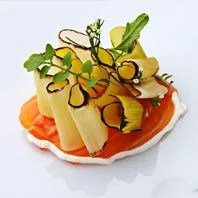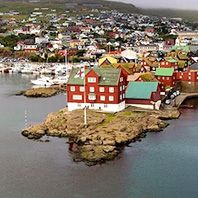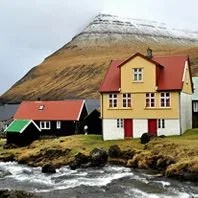There’s no place to hide in the Faroe Islands. It’s a treeless Moonscape, and a beautiful one at that. The smooth, sculpted landscape crests and dips like waves, sometimes stopping short at the highest sea cliffs in Europe, other times sloping inch by inch straight down to the sea. Every village is in a valley. When you climb a few feet up a nearby slope, you can grasp the entirety of the hamlet below as if it were a tiny model.
Yet the small islands, a property of Denmark in the northern Atlantic Ocean — with a population of 50,000 and the approximate land mass of Cape Cod, Martha’s Vineyard and Nantucket combined — possess much to explore. The cliffs alone are a world in themselves, often harboring huge populations of puffins, storm petrels and other sea birds. The tiny villages — Gjógv, Tjørnuvík, Kirkjubøur, and dozens of others — are both time capsules of the islands’ long maritime (and Viking) history and modern, well-kept outposts of Faroese culture. The two main towns, the capital Tórshavn to the south and the smaller Klaksvik to the east, offer the gamut of dining, shopping, culture and entertainment options.
To get to the Faroes, you connect to Vagar Airport through Norway, Iceland, the UK or Denmark — there are only a few flights per day, most run by Faroese carrier Atlantic Airways or Scandinavian Airlines. The airport’s a breeze — you’ll be in full exploration mode within 30 minutes of touchdown. There are also ferries from Copenhagen, if you prefer a more nautical approach (here’s more general intel). Just be sure to bring a rain suit — both pants and hooded jacket. Weather is unpredictable and often veers from sunny to soaking in minutes. Also, bring your camera: Every inch of this place you’ll want to put into a megapixel capsule.

Where to Stay
Hotels in the Faroe Islands are what you’d expect to find in mainland Scandinavia — that is, sleek and modern. I stayed at Hotel Havn in downtown Tórshavn. This attractive, recently expanded hotel sits just a few minutes’ walk from multiple restaurants and bars, and about a 10-minute walk to the historic harbor fort Skansin. The hotel itself has clean, spare rooms and easy on-street parking right outside. (The hotel will even rent you a car — and at a significant discount compared to other car rental operations. If you didn’t want to rent a car, you could stay downtown and take advantage of the reliable and efficient bus network around the islands.) Another highly regarded hotel, Hotel Føroyar, sits on a hill overlooking Tórshavn and the harbor. This facility has the added option of a hostel on the premises — Kerjalon — that uses communal baths and kitchens and hosts multiple guests per room to keep rates at roughly 1/4 that of the main hotel. (Havn has a hostel option, as well.) Other hotels in downtown Tórshavn include the four-star Hotel Hafnia and the Hotel Tórshavn, which has a terrific close-up view of the harbor. There are more hotels throughout the islands, including the three-star Hotel Vagar near the airport, as well as hostels, bed-and-breakfasts, and even tent sites.

Where to Eat
While exploring, it’s sometimes hard to find places to eat — many of the small villages have no restaurants at all, and you may occasionally find yourself cobbling together a meal from the (usually nice and well appointed) convenience stores at gas stations. But in larger towns, there are great options. Tórshavn has many terrific representations of increasingly highly regarded Faroese cuisine, including the modern, seafood-based Koks, located at Hotel Føroyar, Barbara Fish House and the white-linen restaurant Hafnia, in Hotel Hafnia. Thanks to the abundant fresh seafood available in the Faroes, the Japanese sushi restaurant Etika is sensational. There are also plenty of carry-out places — pizza, burgers, and a small mall called SMS that even hosts the islands’ only drive-through. It’s a Burger King, as if placed there solely for homesick Americans.


